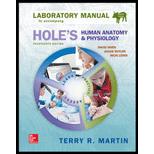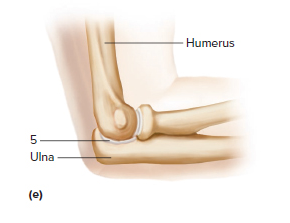
Laboratory Manual for Holes Human Anatomy & Physiology Fetal Pig Version
14th Edition
ISBN: 9781259295645
Author: Terry R. Martin
Publisher: McGraw-Hill Education
expand_more
expand_more
format_list_bulleted
Concept explainers
Textbook Question
Chapter 18, Problem 2.5A
Identify the types of structural and functional joints numbered in figure 19.7.
Structural Classification
Functional Classification
5. ___________________
_______________________

Expert Solution & Answer
Want to see the full answer?
Check out a sample textbook solution
Students have asked these similar questions
If someone was working with a 50 MBq F-18 source, what would be the internal and external dose consequences?
We will be starting a group project next week where you and your group will research and ultimately present on a current research article related to the biology of a pathogen that infects humans. The article could be about the pathogen itself, the disease process related to the pathogen, the immune response to the pathogen, vaccines or treatments that affect the pathogen, or other biology-related study about the pathogen.
I recommend that you choose a pathogen that is currently interesting to researchers, so that you will be able to find plenty of articles about it. Avoid choosing a historical disease that no longer circulates.
List 3 possible pathogens or diseases that you might want to do for your group project.
not use ai please
Chapter 18 Solutions
Laboratory Manual for Holes Human Anatomy & Physiology Fetal Pig Version
Ch. 18 - Match the terms in column A with the descriptions...Ch. 18 - Identify the types of structural and functional...Ch. 18 - Identify the types of structural and functional...Ch. 18 - Identify the types of structural and functional...Ch. 18 - Identify the types of structural and functional...Ch. 18 - Identify the types of structural and functional...Ch. 18 - Identify the types of structural and functional...Ch. 18 - Identify the types of structural and functional...Ch. 18 - Identify the types of structural and functional...Ch. 18 - Identify the types of structural and functional...
Ch. 18 - Prob. F18.4ACh. 18 - Match the types of synovial joints in column A...Ch. 18 - Complete the missing components of the following...Ch. 18 - Identify the types of joint movements numbered in...Ch. 18 - Identify the types of joint movements numbered in...Ch. 18 - Identify the types of joint movements numbered in...Ch. 18 - Identify the types of joint movements numbered in...Ch. 18 - Identify the types of joint movements numbered in...Ch. 18 - Identify the types of joint movements numbered in...Ch. 18 - Identify the types of joint movements numbered in...Ch. 18 - Identify the types of joint movements numbered in...Ch. 18 - Identify the types of joint movements numbered in...Ch. 18 - Identify the types of joint movements numbered in...Ch. 18 - Identify the types of joint movements numbered in...Ch. 18 - Identify the types of joint movements numbered in...Ch. 18 - Identify the types of joint movements numbered in...Ch. 18 - Identify the types of joint movements numbered in...Ch. 18 - Identify the types of joint movements numbered in...Ch. 18 - Identify the types of joint movements numbered in...Ch. 18 - Identify the types of joint movements numbered in...Ch. 18 - Identify the types of joint movements numbered in...Ch. 18 - Identify the types of joint movements numbered in...Ch. 18 - Identify the types of joint movements numbered in...Ch. 18 - Identify the types of joint movements numbered in...Ch. 18 - Identify the types of joint movements numbered in...Ch. 18 - Identify the types of joint movements numbered in...Ch. 18 - Identify the types of joint movements numbered in...Ch. 18 - Identify the types of joint movements numbered in...Ch. 18 - Identify the types of joint movements numbered in...Ch. 18 - Identify the types of joint movements numbered in...Ch. 18 - Identify the types of joint movements numbered in...
Additional Science Textbook Solutions
Find more solutions based on key concepts
An obese 55-year-old woman consults her physician about minor chest pains during exercise. Explain the physicia...
Biology: Life on Earth with Physiology (11th Edition)
How does the removal of hydrogen atoms from nutrient molecules result in a loss of energy from the nutrient mol...
SEELEY'S ANATOMY+PHYSIOLOGY
Describe the role and impact of microbes on the earth.
Microbiology Fundamentals: A Clinical Approach
On what molecule does the anticodon appear? Explain the role of this molecule in protein synthesis.
Human Physiology: An Integrated Approach (8th Edition)
Knowledge Booster
Learn more about
Need a deep-dive on the concept behind this application? Look no further. Learn more about this topic, biology and related others by exploring similar questions and additional content below.Similar questions
- DNK dagi nukleotidlar va undan sintezlangan oqsildagi peptid boglar farqi 901 taga teng bo'lib undagi A jami H boglardan 6,5 marta kam bo'lsa DNK dagi jami H bog‘lar sonini topingarrow_forwardOne of the ways for a cell to generate ATP is through the oxidative phosphorylation. In oxidative phosphorylation 3 ATP are produced from every one NADH molecule. In respiration, every glucose molecule produces 10 NADH molecules. If a cell is growing on 5 glucose molecules, how much ATP can be produced using oxidative phosphorylation/aerobic respiration?arrow_forwardIf a cell is growing on 5 glucose molecules, how much ATP can be produced using oxidative phosphorylation/aerobic respiration?arrow_forward
- Identify the indicated cavity (Fucus). a. antheridia b. conceptacel c. receptacle d. oogonium e. none of thesearrow_forwardIdentify the indicated structure (Saprolegnia). a. antheridium O b. oospore c.sperm d. auxospore e. tetraspore Of. zygosporearrow_forwardUsing information from the primary literature (several references have been provided as a starting point below) please answer the following question: Based on your review of the literature on rewilding, what are the major scientific pros and cons for rewilding? Please note that the focus of this assignment are the (biological) scientific issues associated with rewilding. As will be discussed in class, there are a number of non-scientific issues involved or implicated in rewilding, all ultimately affecting the public acceptability of rewilding. Although these issues are important – indeed, critical – in this assignment you should focus on the biological science issues and questions. Details: You must enumerate at least two pros and at least two cons. Your answer should be no more than 500 well-chosen words, excluding references. Think carefully about how best to organize and structure your answer. Aim for high information density: say a lot, but say it succinctly. Recall Nietzche’s…arrow_forward
- Using information from the primary literature (several references have been provided as a starting point below) please answer the following question: Based on your review of the literature on rewilding, what are the major scientific pros and cons for rewilding? Please note that the focus of this assignment are the (biological) scientific issues associated with rewilding. As will be discussed in class, there are a number of non-scientific issues involved or implicated in rewilding, all ultimately affecting the public acceptability of rewilding. Although these issues are important – indeed, critical – in this assignment you should focus on the biological science issues and questions. Details: You must enumerate at least two pros and at least two cons. Your answer should be no more than 500 well-chosen words, excluding references. Think carefully about how best to organize and structure your answer. Aim for high information density: say a lot, but say it succinctly. Recall Nietzche’s…arrow_forwardNow draw a rough sketch of what the control data might look like if in addition to the specific binding, there was also a considerable amount of nonspecific binding (again using a normal dose/response curve) (do % total bound ligand vs concentration)arrow_forwardWhat are functions of cuboidal cells in the kidney? Select all that apply. Concentration of gases Dilution of chemicals Secretion of molecules Nutrition to tissues Support of tissues Absorption of moleculesarrow_forward
arrow_back_ios
SEE MORE QUESTIONS
arrow_forward_ios
Recommended textbooks for you
 Fundamentals of Sectional Anatomy: An Imaging App...BiologyISBN:9781133960867Author:Denise L. LazoPublisher:Cengage Learning
Fundamentals of Sectional Anatomy: An Imaging App...BiologyISBN:9781133960867Author:Denise L. LazoPublisher:Cengage Learning



Fundamentals of Sectional Anatomy: An Imaging App...
Biology
ISBN:9781133960867
Author:Denise L. Lazo
Publisher:Cengage Learning



Chapter 7 - Human Movement Science; Author: Dr. Jeff Williams;https://www.youtube.com/watch?v=LlqElkn4PA4;License: Standard youtube license